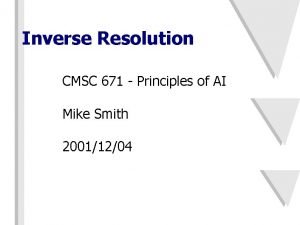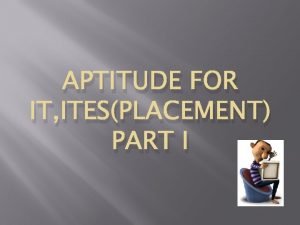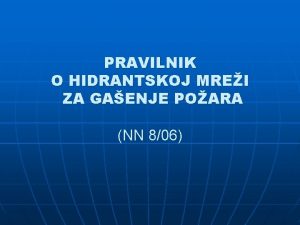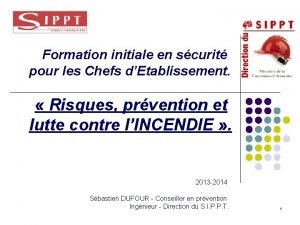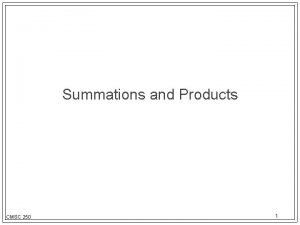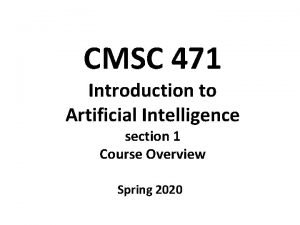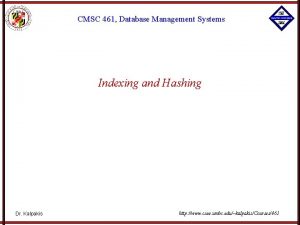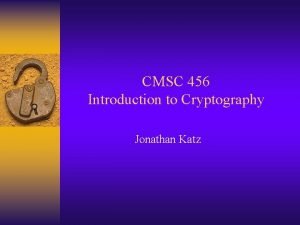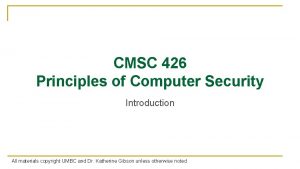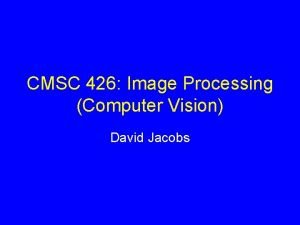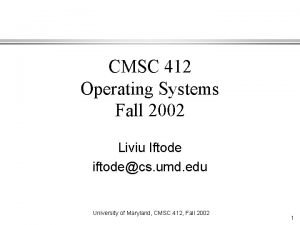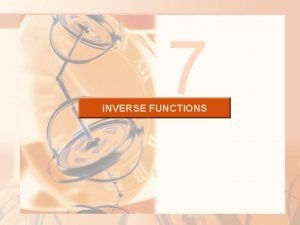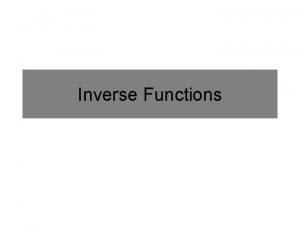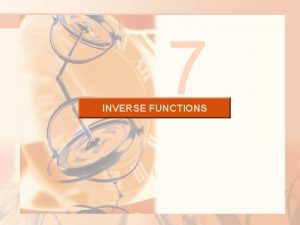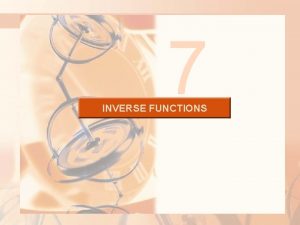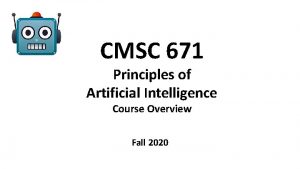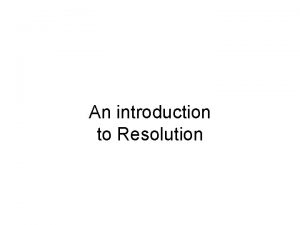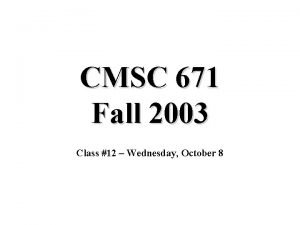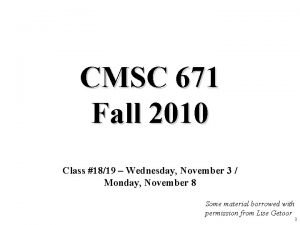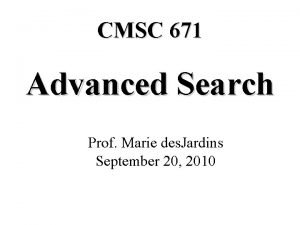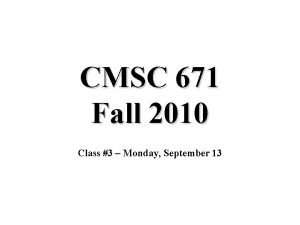Inverse Resolution CMSC 671 Principles of AI Mike















- Slides: 15

Inverse Resolution CMSC 671 - Principles of AI Mike Smith 2001/12/04

Inverse Resolution Why invert resolution? Wasn't resolution hard enough? A We can work resolution graphs backwards A We can learn theories from examples A We can use background knowledge to help A Inverse resolution can be "lifted" to FOL A We can capture knowledge beyond attributes A We can interpret the resulting theories

Inverse Resolution – Learning Framework A Deductive framework: T entails E A Break T into B, H A Inductive framework: B ^ H entails E A Build set of resolution trees backwards from roots A New leaves not in prior knowledge are hypothesis Legend: T = Theory B = Background Knowledge H = Hypothesis E = Examples

Inverting Resolution A Four Rules A Absorption A Identification A Intra-construction A Inter-construction

Absorption q <- A p <- A, B q <- A p <- q, B We can create a new clause p <- q, B by absorbing a conjunction of atoms (A) in the premise into a single atom (q) of the other clause q <- A p <- q, B p <- A, B

Absorption – Example B parent(ann, mary) female(mary) father(henry, jane) <parent(henry, jane) female(mary) E daughter(mary, ann) grandfather(henry, john) <parent(henry, jane), parent(jane, john) grandfather(henry, john) <parent(henry, jane), male(henry) daughter(X, Y) <- female(X), parent(Y, X) -1= {mary/X} parent(ann, mary) Absorption #2 daughter(mary, Y)<-parent(Y, mary) -1= {ann/Y} daughter(mary, ann) Absorption #1

Identification p <- A, B p <- A, q q <- B p <- A, q Because A, B and A, q have the same conclusion, B can be identified by q. p <- A, q q <- B p <- A, B

Intra-Construction p <- A, B q <- B p <- A, C p <- A, q q <- C Construct a clause that represents the similarity between the two clauses, (p <- A, q) and then q<-B and q<-C come from applying the identification rule. q <- B p <- A, q p <- A, B q <- C p <- A, C

Intra-Construction Example B parent(ann, mary) female(mary) father(henry, jane) <parent(henry, jane) E daughter(mary, ann) grandfather(henry, john) <parent(henry, jane), parent(jane, john) grandfather(henry, john) <parent(henry, jane), male(henry) q(henry, jane) <- <father(henry, jane) parent(henry, jane) q(henry, jane) <- <father(henry, jane) male(henry) grandfather(henry, john) <<grandfather(henry, john) parent(henry, jane), q(henry, jane) father(henry, jane) grandfather(henry, john) <parent(henry, jane), parent(jane, john) grandfather(henry, john) <parent(henry, jane), male(henry)

Inter-Construction p <- A, B p <- r, B q <- A, C r <- A q <- r, C Noting the common variable A, construct a clause r <- A (r is new atom). The remaining two conclusive clauses are the result of applying the absorption rule. p <- r, B r <- A p <- A, B q <- r, C p <- A, C

Using Inverse Resolution A Inductive Logic Programming (ILP) A ILP = Inductive Methods + Logic Programming A Two Major Induction Methods A Inverse Resolution A Top-Down Learning Methods

ILP Systems

Inductive Logic Programming Common Applications ALife Sciences / Molecular Biology A Predict 3 D Protein Structures from Amino Acid Sequences A Predict Therapeutic Efficacy of Drugs A Predict Mutagenesis of Compounds ANatural Language A Learning Part of Speech Tagging A Learning Parsers

References A Camacho. (1994). The Use of Background Knowledge in Inductive Logic Programming. http: //citeseer. nj. nec. com/camacho 94 use. html A Muggleton. (199? ). Inductive Logic Programming. http: //www. cs. york. ac. uk/mlg/ilp. html A Russell & Norvig. (1995). Artificial Intelligence: A Modern A van der Poel. (2000). Inductive Logic Programming - Theory. Approach. http: //ww. kbs. twi. tudelft. nl/Education/Cyberles/Trondheim/ILP/html/ilp_th_01 introd. html A Wang. (2000). Parallel Inductive Logic in Data Mining. http: //citeseer. nj. nec. com/wang 00 parallel. html A Weber. (1996). ILP Systems on the ILPnet Systems Repository http: //www-ai. ijs. si/ilpnet/irenefinal. ps

Questions?
 Ai 671
Ai 671 How to activate voice mail in airtel
How to activate voice mail in airtel Find the odd one : 396, 462, 572, 427, 671, 264
Find the odd one : 396, 462, 572, 427, 671, 264 Dužina cijevi u zidnom hidrantu
Dužina cijevi u zidnom hidrantu Nbn s21 204
Nbn s21 204 High resolution low resolution
High resolution low resolution Mike hughes magenta principles
Mike hughes magenta principles Cmsc 104 umbc
Cmsc 104 umbc Cmsc 250
Cmsc 250 Cmsc 417
Cmsc 417 Cmsc 471
Cmsc 471 Cmsc 461
Cmsc 461 Cmsc 456 3 cryptology cryptology.com
Cmsc 456 3 cryptology cryptology.com Umbc cmsc 426
Umbc cmsc 426 Cmsc426
Cmsc426 Cmsc 412
Cmsc 412
